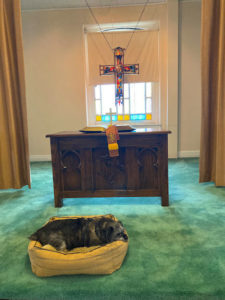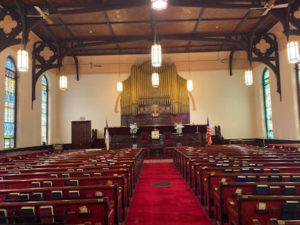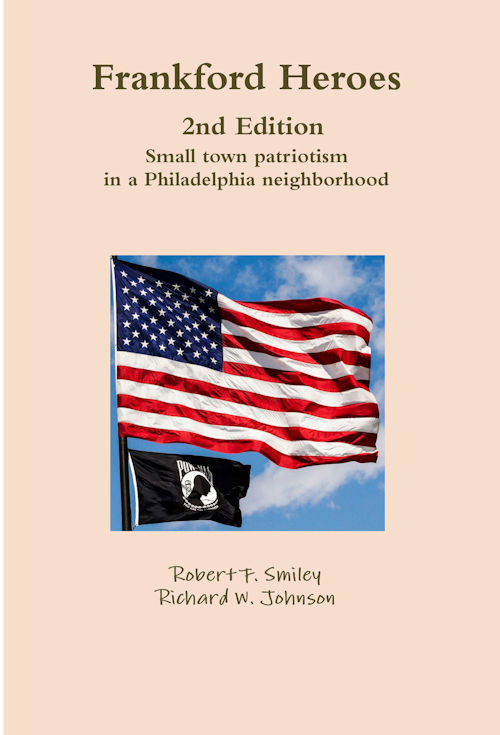The Pink Church
That Changed the Course of My Life
250 Years Ago
by Carol Schaefer
I feel I have been “mystically transported” here, I explained half-joking to Pastor John Sweet of the Frankford Presbyterian Church, when I called to inquire about services.

“Astral projection is not one of our beliefs,” he kidded back.
But mystically transported was how I began to think of my move to Philadelphia from New York City three years before. I was born in Temple University Hospital, but left Philadelphia at six weeks old, when my father took a job in Ohio. I returned to Philadelphia, I thought, because my youngest son, Kip, had moved to Jenkintown with his family. After looking all around Philadelphia for a place to live, my partner, Art, and I found an apartment in Germantown, in a beautiful old home that had been divided into six separate apartments. Little did I know at the time that, in 1757, my fifth great grandparents had been married in the Market Square Church less than a mile away from our new home.
My sister, Jill, is the family historian. She had done extensive research on Ancestry and learned that our fifth great grandfather, Jacob Neff, and his younger brother, Rudolph, natives of Zurich, Switzerland, sailed here from Rotterdam, Holland on the ship Priscilla. Their parents had died a few years before and they were the youngest of the siblings, respectively twenty-five and twenty-one years of age. The journey lasted from the beginning of May until their arrival in Philadelphia in September 1749. The voyage, typical of all ships then, was pure misery. The old and heavily salted food and meat created all sorts of foul diseases, and the water was black and thick, too disgusting to want to quench even the greatest thirst. Many died along the way. Many wished they had remained at home and lived in the pigsty, instead.
Upon arrival, the brothers knocked on the door of the widow Hannah Morse, who lived with her son and daughter in Frankford, hoping to find room and board there. They spoke little English, but were able to convey their need and the “Widow Morse” took them in for seven shillings and six-pence a week. They had brought money with them from their inheritance, but needed to find work. Nearby their lodgings, they came upon a group of men who were digging a cellar for a new house, and were hired, the first of many jobs that got them established in their new country.
They became like family to the Morse’s over the next few years. Rudolph and Hannah, the daughter, became even closer, and were married six years later. Rudolph had saved a good deal of money by then and was able to purchase the very house that he had dug the cellar for on his first job. Jacob and the widow Morse moved in with the new couple, but she died a few weeks later.
Over the years, Rudolph was able to accumulate enough money to buy land and then sell for a profit, becoming a wealthy, well-liked and respected businessman. Jacob was just as successful. In December of 1962, he purchased 100 acres in Oxford Township from Philip Syng, a renowned silversmith, who is believed to have designed the inkwell for the signing of the Declaration of Independence.
Jill came for a visit and we dug deeper into our roots. That’s when we discovered the brothers were members of the Market Square Church in Germantown, where Jacob married Anna Buser from Basel, Switzerland in 1757. (I was thrilled to find out I’d been rooting for the hometown hero, Roger Federer, all along!) Jill had been vaguely aware that, in 1760, the brothers had founded, along with a couple of other men, a church in Frankford. The significance had not registered for some reason and so we didn’t explore that part of their lives.
Somewhere along the way, Jacob and Rudolph met George Castor. Castor was born to a single mother, who was abandoned by his father and refused to even acknowledge his existence. With no father to claim paternity, Castor was not granted Swiss citizenship. Thus, when at the age of twenty-six he arrived in Philadelphia to seek his fortune, he was considered illegal and the British confiscated his property. Like Jacob and Rudolph, he worked at first as a day laborer, but then developed a trade of weaving linen from flax and became quite wealthy.
The three men together used some of their wealth to buy land to create a German Reform church in Frankford, which was affiliated with the Market Square Church. Originally, the land was to be used only as a cemetery, but a church was also built on the property in 1770 and served by the same pastor. The original edifice of the church was just forty feet wide and thirty feet long. Records were either not kept or were lost, so not much is known about the early history of the church, with one important exception that occurred seven years after its founding.
After the Battle of Trenton on December 26, 1776, during the Revolutionary War, some of the Hessian solders captured were imprisoned in the little church, perhaps at the suggestion of Rudolph Neff. As we later learned, Rudolph was captain of a company in the Philadelphia Battalion of the Flying Camp, commanded by Colonel Robert Lewis. George Washington’s Flying Camps were meant to go where needed to plug holes in the regular army’s defense. Rudolph’s company was with George Washington as he crossed the Delaware to win the Battle of Trenton. That was a remarkable fact of family history to uncover.
When we first moved to Germantown, I loved pondering that I might be walking in my ancestors’ footsteps whenever visiting the city, not yet knowing how really close by they had been. They had to have spent some time in the Old City, I was sure. That first fall here, Art and I attended the reenactment of the Battle of Germantown. The fog was heavy that day and, along with the smoke from the canons, created an eerie atmosphere, as if we were back in time. It wasn’t until a year and a half later, when I did research at the Germantown Historical Society, located right next to the Market Square Church, that I learned my fifth great grandfather, Jacob, had fought in the Battle of Germantown as a private. Apparently, I knew where their footsteps were, but I just didn’t know that I did.
Kip was moving his family back to Mill Valley, California, where he grew up and I had lived for thirty years, and wanted to get together one last time before he left. Where did I want to go? It came to me that we should try to find that church our ancestors had founded and where we now knew they were buried. That seemed appropriate. So we headed to Frankford and located the church at the corner of Frankford and Church. It was far more impressive than I expected. I had not yet learned that the present structure was built in 1860, 100 years after the original church was erected. It was now called Frankford Presbyterian Church, having formally dropped its connection to the German Reform body in 1807 and assimilating its thirty families.
The church was unexpectedly colored pink and very pretty, but closed off by a chain link fence, so we couldn’t walk the grounds. Elevated tracks for Septa trains hung over the street in front of the church, and storefronts, some marked with graffiti, lined the other side of Frankford Avenue, also known as part of King’s Highway, the oldest road in the United States and connects Charleston, South Carolina to Boston, Massachusetts. What would the original inhabitants think of what happened to their once treasured and beautiful little town, I wondered.
Kip and I peeked through the fence at the cemetery, trying to guess which headstones belonged to our ancestors. We’d read that they were buried along the back wall of the church, but it was impossible to figure out through the fence. We took photos with our IPhones, and left, a bit in awe of tracing our roots to when our ancestors on my mother’s father’s side first came to this country in the 1700’s.
COVID hit soon after, so I didn’t try to visit the church again. When the pandemic began to wane last year, I decided to call the church to check if services were being held. The only way I can explain the urge to attend is that I had a nagging feeling of having unfinished business, even though that feeling made no sense.
Pastor Sweet answered the phone himself and informed me services were on Sundays at 11:00. I told him that my fifth great grandfather, Jacob Neff, was one of the original founders of the church, along with my fifth great uncle Rudolph. He said he looked forward to meeting me on Sunday.
Art went with me, as excited as I was. When we pulled into the parking area, a member motioned for us to enter through the side door. Inside was impressive. I had learned that the architect for the existing building, finished in 1860, was John McArthur, Jr., best known as the architect for Philadelphia’s City Hall, no less.
Pastor Sweet walked up and greeted us warmly, his little aging dog Finnegan toddling behind him. We felt welcomed right away. He explained that church membership reached its peak of 1,034 in 1930, but many factors, including the overhead railway line, the decaying downtown, the changing population of Frankford and now COVID had reduced the membership to twenty-two. Half that number was gathered in a room that served as the office. We were introduced and everyone was quite friendly. Pastor Sweet explained my connection and promised a tour after the service. He especially wanted me to see the stained glass window in the sanctuary dedicated to Rudolph Neff. I wondered why not Jacob, too.
It was time for services to begin. All was very informal. The services were held these days in a large room on the main floor. With so few attending and some of them too frail to climb the stairs to the second floor sanctuary, this room was the better choice. Finnegan slowly climbed the couple of stairs up to the elevated platform that served as an altar of sorts, and nestled down in his bed that was in front of a table, with a bible resting on it and a stained glass cross hanging above. The ten attending, which included us, sat on folding chairs. Pastor Sweet held the service from the floor.

Afterwards, we got the full tour. Before going up to the sanctuary, Pastor Sweet showed us the downstairs. We walked through a gaily-decorated room that once had been used for the children’s Sunday school, now sadly languishing. A door led to a small room that revealed the structure of the building. In there, Pastor Sweet said was what he believed to be part of a wall from the original building from 250 years before.
We climbed the stairs up to the sanctuary. Pastor Sweet, Finnegan tucked under his arm, unlocked the door. I was not expecting to see such a stunning sight. The organ, installed in 1865, was impressive, as were the beautiful wooden pews and rich wooden altar area. Deep red carpeting connected everything. Gorgeous stain glass windows lined the walls. Pastor Sweet pointed out that George Castor’s window on the left was exactly opposite Rudolph’s on the right. It was clear that the founders were deeply revered. The windows were installed 100 years after the original church was built. I mentioned Jacob, wondering where his dedication was, but got no response. Something didn’t feel quite right.

We took lots of photos and then returned downstairs. I asked if it was possible to open the gate to the cemetery, so we could maybe find the headstones for Jacob and Rudolph. Pastor Sweet agreed and said he would meet us out there in a few minutes. Please don’t leave until he returns.
Acid rain had washed away the engravings on the headstones long ago. We had to be content knowing we were standing close to their graves. When Pastor Sweet finally came out to meet us, he explained that those buried there were all from the first hundred years. Then he said he had a huge apology to make. I had no idea what he could be talking about.
“You kept talking about your fifth great grandfather, Jacob, but I had never heard of him. I’d only known about Rudolph. While you were in the cemetery, I looked through all the books and at last found him in the original German book from that time.” He looked stricken, as he apologized over and over again. “He must have gotten lost in one of the translations,” he explained, promising to take the matter up at the next meeting. Jacob needed to be reinstated as one of the founders.
That explained everything – why I was feeling something was off, but mostly why I had felt so compelled for so long to visit the church. Jacob wanted things set right! How else was that going to happen, unless I moved to Germantown?
Celebration of the 250th Anniversary of the Church’s founding will be on Sunday, May 1, and Jacob Neff will be recognized as one of its founders. Services will be held in the beautiful sanctuary at 11, and the 150-year-old pipe organ will be played. The Rev. Dr. Leonard Sweet, world-renowned United Methodist theologian/futurist/blogger, author of 60+ books is to be our keynote speaker. His 2019 book Rings of Fire ends by predicting a corona virus pandemic very similar to Covid. Len is John Sweet’s brother. A buffet will follow, free of charge.
Carol Schaefer is the author of six books, including The Other Mother (Soho Press) and Grandmothers Counsel the World (Shambhala Publications).




